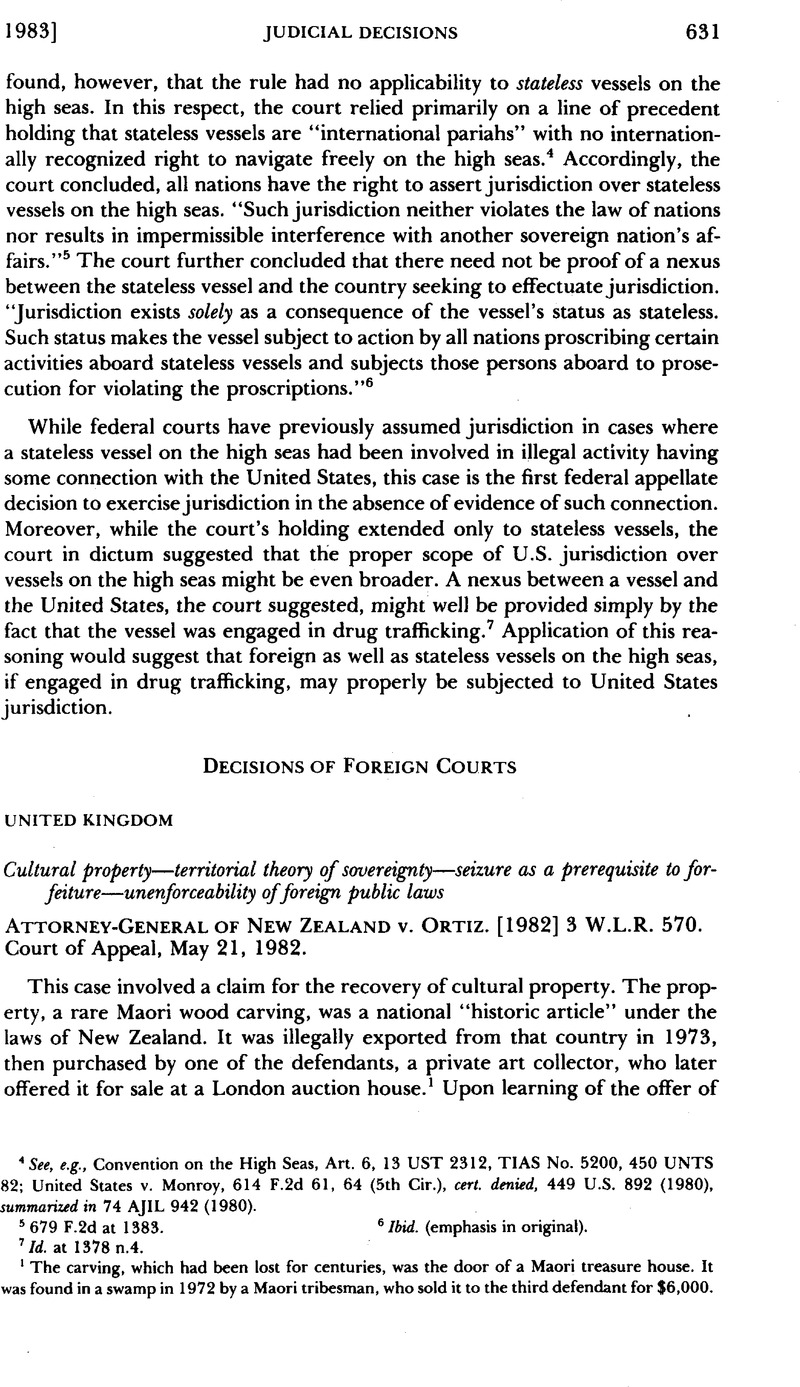No CrossRef data available.
Article contents
Attorney-General of New Zealand v. Ortiz
Published online by Cambridge University Press: 27 February 2017
Abstract

- Type
- Judicial Decisions
- Information
- Copyright
- Copyright © American Society of International Law 1983
References
1 The carving, which had been lost for centuries, was the door of a Maori treasure house. It was found in a swamp in 1972 by a Maori tribesman, who sold it to the third defendant for $6,000. The first defendant then purchased it for $65,000 and later offered it for sale to the public through Sotheby’s (the second defendant). The estimated value of the carving at the time of auction was f 300,000.
2 1982 Q.B. 349, [1982] 2 W.L.R. 10.
3 Historic Articles Act 1962, sees. 5 and 12 (NZ). It was apparently not disputed that the carving at issue was a “historic article” within the meaning of the Act.
4 Customs Act 1966, sees. 275(4) and 276 (NZ).
5 [1982] 3 W.L.R. 570, 576.
6 Ibid.
7 Id. at 580 (citing The Apollon, 22 U.S. (9 Wheat.) 362, 370 (1824)).
8 Denning distinguished, however, between a suit by a foreign state to enforce its laws and a suit between private firms or individuals where foreign laws are at issue. [1982] 3 W.L.R. at 581.
9 Cf. Restatement (Second) of Foreign Relations Law of the United States §41, Comment 1 (1965) (“courts in the United States will generally refrain from taking action to give effect to the penal or revenue law of other states, except as provided by international agreement”).
10 [1982] 3 W.L.R. at 585.
11 Id. at 591.
12 See generally Bator, , An Essay on the International Trade in Art, 34 Stan. L. Rev. 275 (1982)CrossRefGoogle Scholar; Duboff, L., The Deskbook of Art Law, ch. IV (1977)Google Scholar.
13 See, e.g., Treaty of Cooperation Between the United States of America and the United Mexican States Providing for the Recovery and Return of Stolen Archaeological, Historical and Cultural Properties, July 17, 1970, 22 UST 494, TIAS No. 7088; Pan American Treaty of 1936 on the Protection of Movable Property of Historic Value, 28 OASTS (1962).
14 Currently, there are approximately 50 parties to the Convention, including the United States. The United States was significantly involved in drafting the Convention, but U.S. implementing legislation was delayed for over a decade. See Convention on Cultural Property Implementation Act, 19 U.S.C. §2601 et seq. (Supp. V 1981). See also 76 AJIL 611 (1982).
15 545 F.2d 988, 1003 n.33. The court in McClain, however, reversed the lower court’s convictions of the defendants on the ground that the foreign country (Mexico) had not unambiguously declared by statute prior to the date of export that it was the owner of all pre-Columbian artifacts located within its territory. See also United States v. McClain, 593 F.2d 658 (5th Cir. 1979) (McClain II); United States v. Hollinshead, 495 F.2d 1154 (9th Cir. 1974).




